Source: Geek Park
Author: Mei Yi
Editor: Jing Yu
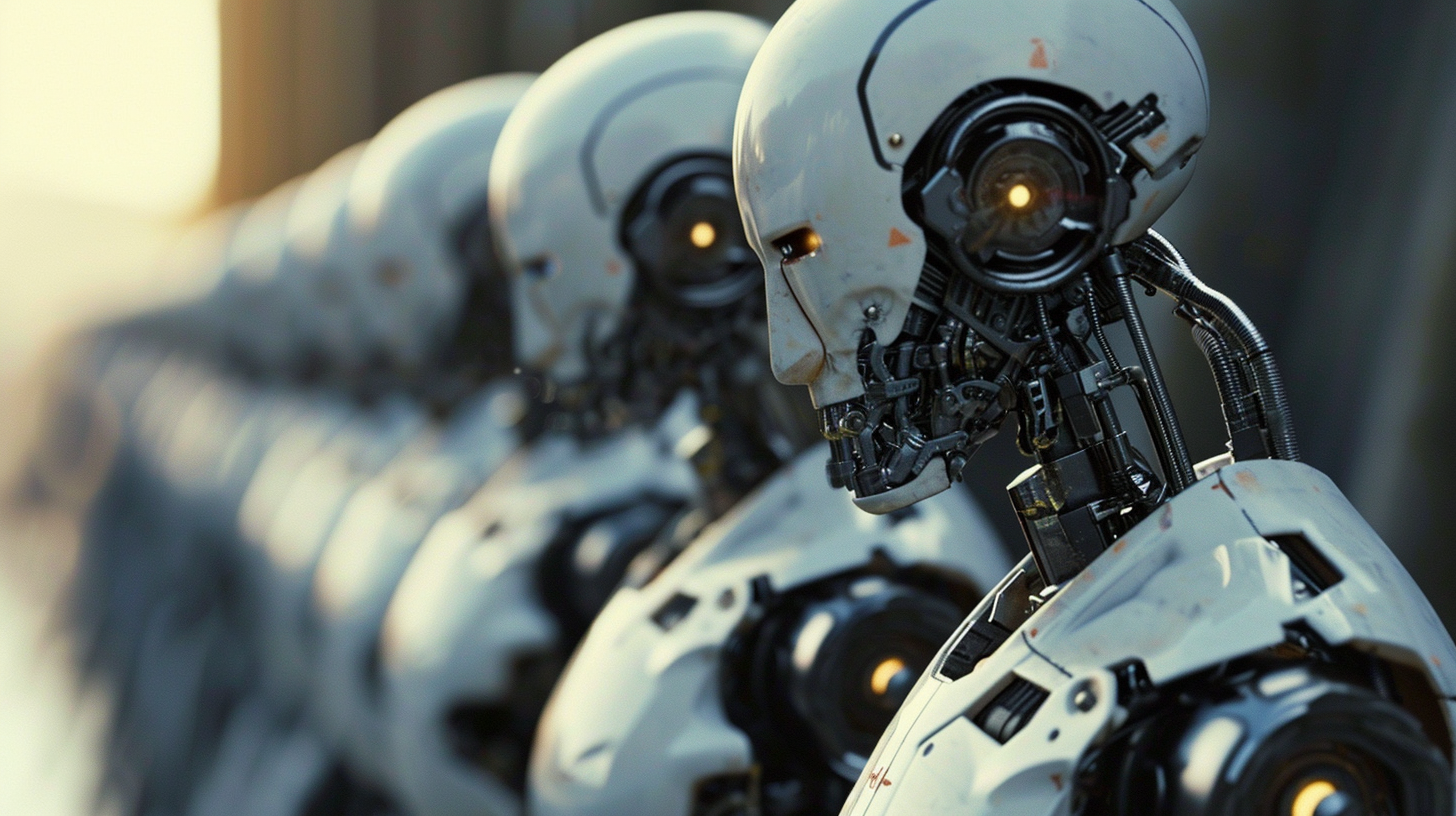
Image Source: Generated by Wujie AI
Who can stop Microsoft now?
After nearly 50 years since its establishment, the old giant Microsoft has risen strongly in recent years. In 2023, it was a big year for Microsoft. On one hand, the shocking acquisition of Activision Blizzard for over 70 billion USD was successfully completed, making the company the third largest game company in the world. On the other hand, as the biggest "patron" of OpenAI, with the help of ChatGPT, Microsoft has become the "leader in AI" among technology giants.
Currently, Microsoft's market value has reached 2.73 trillion USD, with only a 90 million USD difference from its old rival Apple, seemingly surpassing it in an instant.
Recently, a less noticed collaboration seems to have exposed Microsoft's next goal - to integrate games and AI.
Not long ago, Microsoft reached a cooperation with the AI startup Inworld to introduce AI-based "Character Engine" and "Copilot Assistant," providing developers with a series of development tools to create more realistic and dynamic NPCs.
Regarding this cooperation, Microsoft stated, "Using advanced AI technology to inject more interaction and vitality into NPCs in games, thereby enhancing the immersion and experience of the game."
So, why did Inworld, a startup, receive over 100 million USD in financing and latch onto Microsoft's thigh? What kind of impact will their cooperation have on the game industry with AI?
01 How to Create AI NPCs?
Three years ago, a Hollywood blockbuster "Free Guy" made everyone realize what a game would be like with NPCs having their own consciousness.
However, the fact is, if NPCs in a game really had "consciousness," it would be a big help for game companies. Because developing NPCs is really troublesome.
In a large-scale RPG game with a complex plot, countless NPCs need to be developed. For example, in "Red Dead Redemption 2," there are over 1000 NPC characters, each with their own singer, artist, and voice actor, distributed in over 100 missions across 6 chapters, taking nearly 8 years and close to 500 million USD in development costs.
Despite this, research shows that 52% of players are complaining that current NPCs "only repeat dialogue," and 99% of players are expecting more intelligent NPCs, with 81% of players willing to pay more for them.
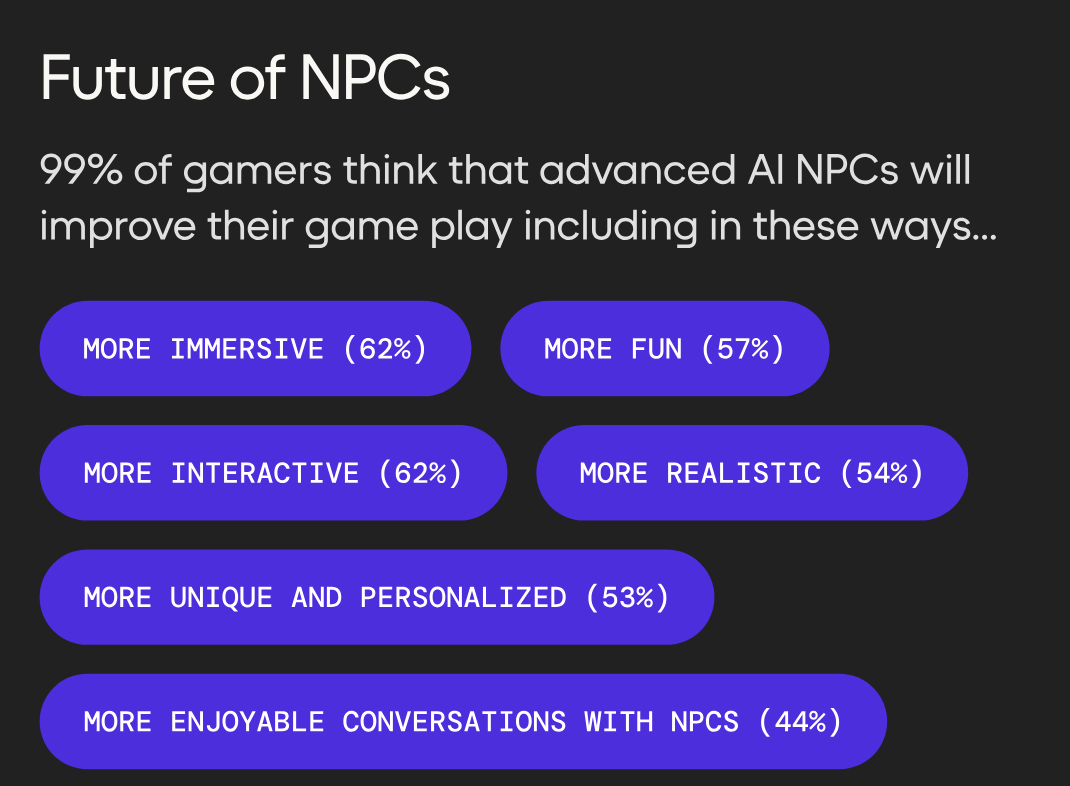
99% of players are expecting more intelligent NPCs | Image Source: Inworld AI Official Website
Therefore, Inworld hopes to create NPCs with "soul," driving NPC behavior dynamically through generative AI to respond to player actions, thereby enhancing the game's "immersion" and reducing development costs.
As a newcomer in the gaming industry, Inworld has received a total financing amount of over 100 million USD, and the company's valuation has reached 500 million USD, making it the most well-funded startup in the AI+ gaming field.
It is evident that Inworld's competitive advantage lies in providing "personalized" AI conversation features, rather than providing AI conversation driven by general machine learning models like traditional players such as OpenAI and Google.
Although with the addition of large AI models, NPCs have more possibilities for dialogue, corresponding facial gestures, body movements, and emotional tones are also necessary for NPCs to converse more smoothly and naturally with players.
Therefore, Inworld trains text, voice, and images as mutually trained data, and based on the GPT-3 core language model, integrates multiple large models, audio models, and over 30 machine learning models to create a multimodal development engine - "Character Engine."
These models are responsible for content generation, information processing, emotion perception, relationship maintenance, and behavior prediction, supporting multimodal character expression.
Therefore, the AI NPCs created by the "Character Engine" can imitate the profound social attributes of human interaction, exhibiting "complex" and "realistic" human behavior, applicable to any character design, thereby helping developers enhance gameplay and increase player engagement. This is also the strength of Inworld.
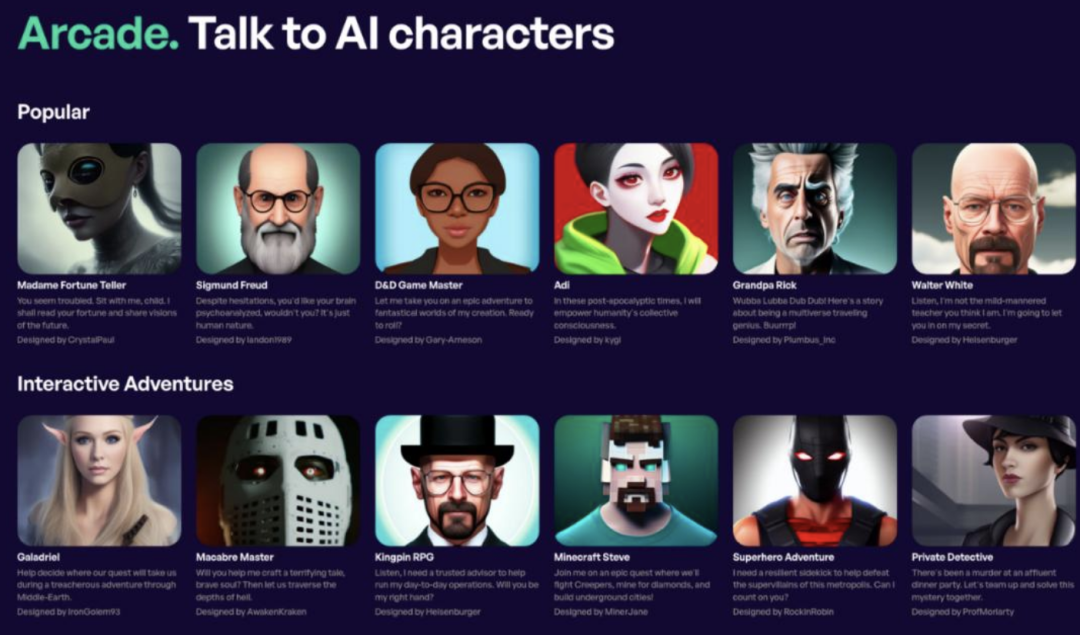
"Character Engine" provides multimodal AI characters | Image Source: Inworld AI Official Website
In fact, the technical architecture of the "Character Engine" aims to build a complex system simulating the human brain, consisting of three layers: Character Brain, Contextual Mesh, and Real-Time AI.
- Character Brain: This layer aims to endow NPCs with cognitive, communication, and behavioral abilities similar to humans using AI technology, allowing AI NPCs to learn and grow from interactions, handle emotional intelligence in interpersonal relationships, have memory and recall capabilities, initiate goals independently, execute actions, and follow their own motivations, thereby driving story development and integrating into a broader player experience.
- Contextual Mesh: This layer aims to prevent AI "illusions" or interactions that violate game logic by allowing developers to set parameters for content and security mechanisms, custom knowledge, and narrative control, ensuring the consistency and rationality of AI characters in various interaction scenarios.
- Real-Time AI: This layer is optimized for real-time experiences, providing scalable low-latency interaction, achieving high-quality interaction with faster reasoning speed and lower cost.
In short, the technical architecture of the "Character Engine" not only simulates the complex structure of the human brain but also involves deep simulation of memory processing, decision-making, and emotional evolution, greatly increasing player "immersion."
To enable users and developers to quickly build and deploy AI characters in games or applications, Inworld has built the AI virtual character generation platform - Inworld Studio, and also provides SDKs for game developers to access NPCs in the Studio.
Creating NPCs in Inworld Studio is very simple, without any code, and can be quickly created by entering natural language.
After logging in, users first need to set the identity of the NPC in a few sentences and adjust the character's personality combination. Then, by setting keywords, they can determine the NPC's life status, background cognition, goal motivation, emotional memory, and more, and can also set specific questions for fixed dialogue.
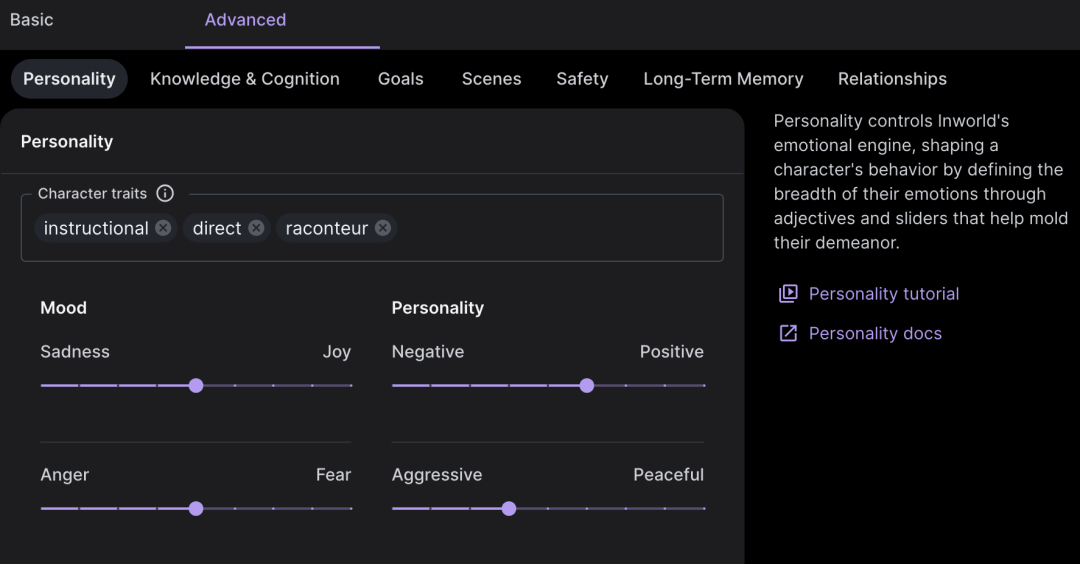
Easily set up NPCs | Image Source: Inworld AI Official Website
After creating AI characters, you can use SDKs compatible with popular game engines such as Unity, Unreal Engine, and Roblox to quickly integrate characters with game scenes, greatly improving delivery speed and enabling deployment anywhere.
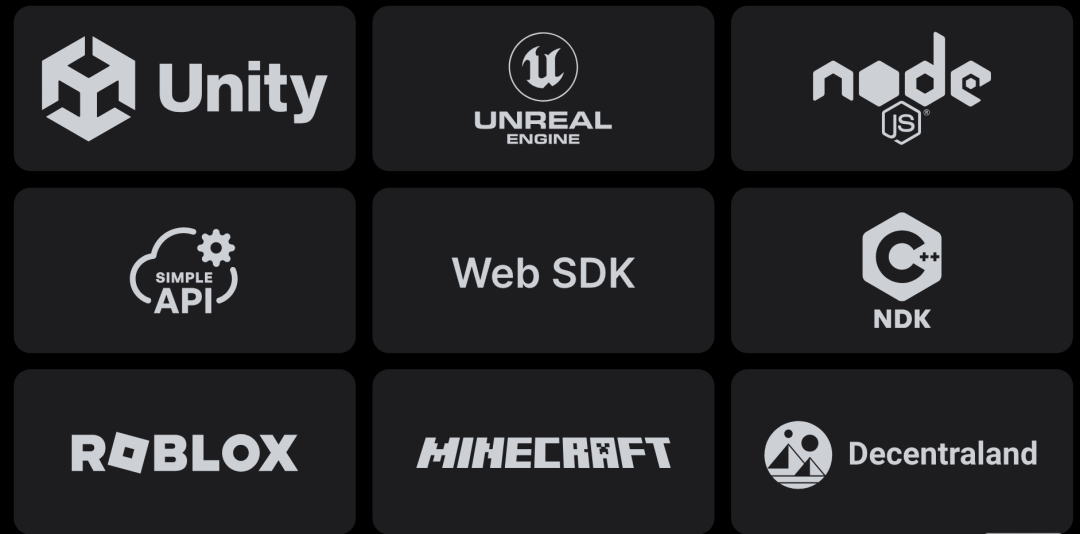
Developers and creators can deploy Inworld AI characters through Unity and Unreal | Image Source: Inworld AI Official Website
It is worth mentioning that the virtual characters generated by Inworld undergo a "training" process before formal interaction and testing, and can be tested in VR through Inworld's Oculus companion app.
Regarding this, Andy Harrison, Managing Partner of Section 32, inf, stated, "Inworld's AI platform eliminates the complexity of developing intelligent virtual characters and has the potential to unlock a variety of new online experiences."
Currently, Inworld has adopted a subscription-based business model, with different pricing standards depending on integration time, overtime costs, feature diversity, and customization level, mainly offering four different standards: Free, $10/month, $50/month, and Custom.
- Free: Unlimited interaction time (excluding Arcade), 200 minutes of integrated interaction time per day, unlimited character creation
- Starter: Unlimited interaction time (including Arcade), 1000 minutes of integrated interaction time per day, ability to create multiple Workspaces
- Professional: 5000 minutes of integrated interaction time per day, ultra-low overtime costs, ability to share Workspaces, analytics features, and access to Beta features
- Custom: Advanced narrative and security controls, customized voice cloning, customized integration and data, offline mode, customer service
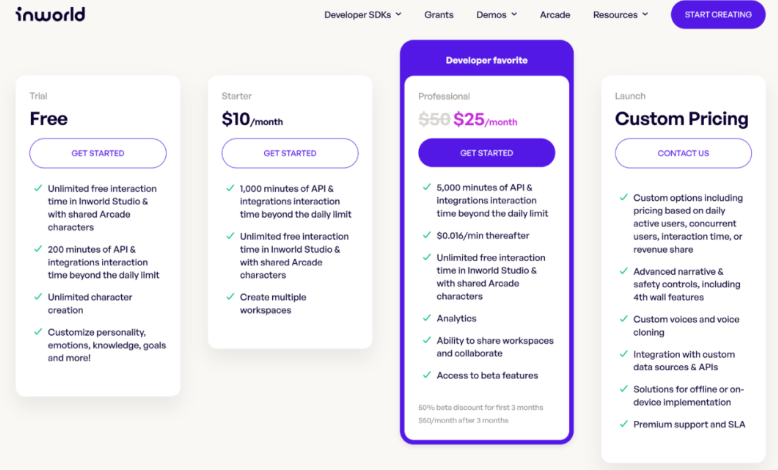
Subscription service pricing | Image Source: Inworld AI Official Website
Inworld's commercial path is to serve small game studios and individual developers; secondly, to collaborate with large game companies on customized projects to help them establish and integrate characters.
Despite this, Inworld's commercial prospects are currently unclear, facing triple pressure from game engines, game companies, and other chatbots in the competition.
02 The People Behind "Character Brain"
Inworld was founded in July 2021 and is headquartered in Silicon Valley, USA. It was co-founded by Ilya Gelfenbeyn, Michael Ermolenko, and Kylan Gibbs, who serve as CEO, CTO, and CPO, respectively.
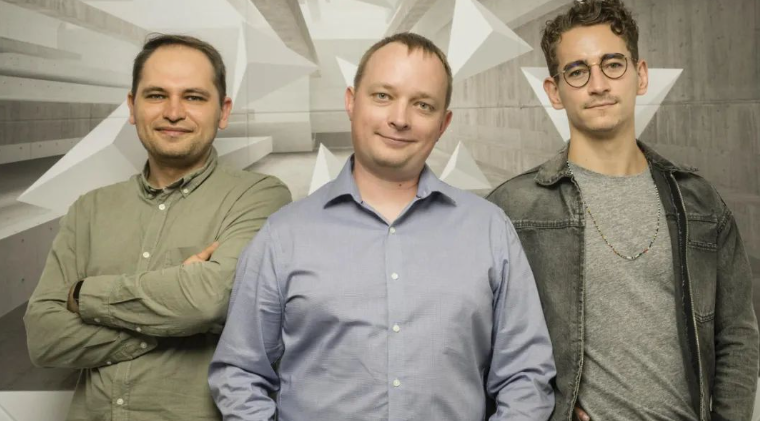
The three co-founders, from left to right, are CTO Michael Emolenko, CEO Ilya Gelfenbeyn, CPO Kulan Gibbs | Image Source: Inworld AI Official Website
These three co-founders have rich work experience in the field of AI.
Ilya Gelfenbeyn and Michael Ermolenko previously founded API.AI, which was acquired by Google and renamed Dialogflow, merging into Google Cloud and becoming the most popular conversational AI platform on the market. Kylan Gibbs previously led the product management of language model products at DeepMind.
Based on their past experiences, they found that the generative AI market for single applications such as voice and text was dominated by large companies like Apple and Google, but there were few platforms that could simultaneously generate text, voice, and images. Therefore, Inworld attempted to fill this gap.
As a result, the goal of the Inworld team is to develop AI NPCs that can learn, adapt, and build relationships with players, while providing high-quality performance and maintaining the "immersion" of the game.
In fact, Inworld's initial goal was to provide freely interactive virtual beings for the metaverse, but with the slow development of the metaverse and the rapid rise of large language models, the team saw the opportunity to combine LLM with NPCs, adjusting their goal to provide the "brain" for virtual characters, while hoping to apply the technology to the entire entertainment industry.
As explained by one of the co-founders of Inworld, Ilya Gelfenbeyn, "We provide a toolkit that allows developers to add brains to the world and different types of environments, making these virtual worlds more appealing."
In addition to building AI NPCs, replicating "social relationships" from real life and creating a "ecosystem" in the virtual world has also become a focus of Inworld's development.
Therefore, Inworld encourages users to create local populations in the virtual world, virtual influencers, and digital humans that can build relationships with users and unlock deeper engagement.
Building truly intelligent virtual characters is complex and requires a lot of specialized technological support. Inworld has currently developed the "brain" for NPCs on its own, but the NPC creation ecosystem also includes visual, avatar, hardware, motion, etc. Therefore, Inworld has established products compatible with these systems, and currently, 3D character models are provided by Ready Player Me.
With its unique "advantages," Inworld AI completed a $7.2 million seed round of financing at the beginning of its establishment, led by Kleiner Perkins and CRV, with Meta participating.
A few months later, Inworld was invited to join the "Disney Accelerator" program. Disney will provide guidance, investment funds, and the opportunity to access shared workspace in Disney's creative park, to jointly create the future of immersive experiences.
On August 23, 2022, Inworld announced the completion of a $50 million Series A financing round, led by Intel Capital and Section 32, with Microsoft's venture capital fund M12 and NTT DoCoMo Ventures participating.

Image Source: Inworld AI Official Website
The new investment will mainly be used for research and development, personnel recruitment, infrastructure investment, and the launch of an open-source version of the "Character Engine."
In response to this, one of the co-founders of Inworld AI, Michael Ermolenko, stated, "Inworld AI's commitment to open source demonstrates our belief in collaboration to drive innovation. We will work with the open-source developer community to promote innovation in generative AI and enhance the entire gaming industry."
Currently, Inworld AI has provided AI-driven NPCs for Team Miaozi (a subsidiary of NetEase Games), Niantic 8th Wall, LG UPlus (South Korea's third-largest mobile operator), Alpine Electronics, Skyrim, Stardew Valley, and Grand Theft Auto V, among others.
Some developers have generously admitted that "player engagement, satisfaction, and retention have all been improved."
Today, Inworld AI has become a trusted resource for developers, and developers are flocking to the platform. They are creating virtual characters for immersive realities including the metaverse, VR/AR, and games, sparking new forms of gaming and media.
03 AI Revolutionizing the Gaming Industry
For a long time, the limitations and possibilities of technology have determined the game worlds that developers can create. The emergence of large language models and generative AI has brought unlimited possibilities for storytelling and character engagement in games.
One of the co-founders of Inworld AI, Kylan Gibbs, stated, "The technology behind AI NPCs will become a catalyst for storytelling, creative expression, and innovation in the new era of gaming. Most future games will be games we have not yet imagined." "Ultimately, the widespread use of AI technology will allow ordinary players to participate in content creation in the game development process, leading to player-driven narratives and strengthening game loops."
Bing Gordon, Chief Product Officer of venture capital firm Kleiner Perkins, also stated, "AI will reshape the world of game players and game designers, placing players at the center of fantasy, creating truly immersive worlds and complex narratives."
This will be a huge opportunity for game companies and game developers.
Shifting from scripted dialogues to player-driven dynamic narratives will enhance game immersion, thereby increasing playability, retention, and revenue.
Srini Ananth, Managing Director of Intel Capital, also publicly stated, "The demand for immersive content and experiences is constantly rising, which will bring about a thriving creator economy and opportunities for individual developers."
Indeed, financial reports show that Microsoft's R&D investment in the gaming and AI fields has been growing for several years, while competitors such as Sony and Nintendo are also continuously strengthening their research and development in game AI technology.
In February 2023, NetEase's mobile game "Justice" officially announced the implementation of the first "Game GPT" in China, with its in-game intelligent NPC system fully driven by AI.
Perfect World has also established an AI research and development center and has applied AI-related technologies to intelligent NPCs, scene modeling, AI drawing, AI storytelling, AI voice acting, and more in games. "The Legend of Mir 2" will feature intelligent NPCs, among other things.

The movie "Free Guy" depicts NPCs achieving "reversal" and rising to power | douban
At the same time, Unity claims to be building an ecosystem of AI game development tools for game creators, entering the market of UGC game production.
However, large AI models still need to solve the expensive computational cost to be widely implemented in the gaming industry. It can be said that in the early stages, these huge costs may be a significant obstacle to the popularization of intelligent NPCs.
In addition to its significance for game companies and developers, the widespread use of AI will also bring opportunities for chip companies that have long supported the gaming industry.
The interaction between powerful chips and games has always been part of Nvidia's success story.
In May of this year, Nvidia announced that it will provide custom AI model foundry services—Avatar Cloud Engine (ACE) for Games. Developers can use this service to build and deploy customized voice, dialogue, and animation AI models in their software and games. Nvidia stated, "This service brings intelligence to NPCs through AI-driven natural language interaction, thereby changing games."
Recently, John Spitzer, Vice President of Performance Technology at Nvidia, publicly stated, "All developers are interested in how AI affects the game development process. He will provide hardware support for a key test of NPCs."
Inworld's attempt may also herald the future of the gaming industry. If the technical path of building AI NPC systems around large language models can be realized and proven, could it be possible that large-scale gaming experiences will no longer be the "exclusive domain" of giants, truly achieving "creative equality" in games?
免责声明:本文章仅代表作者个人观点,不代表本平台的立场和观点。本文章仅供信息分享,不构成对任何人的任何投资建议。用户与作者之间的任何争议,与本平台无关。如网页中刊载的文章或图片涉及侵权,请提供相关的权利证明和身份证明发送邮件到support@aicoin.com,本平台相关工作人员将会进行核查。




